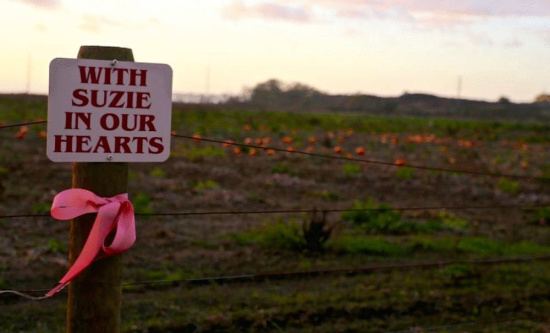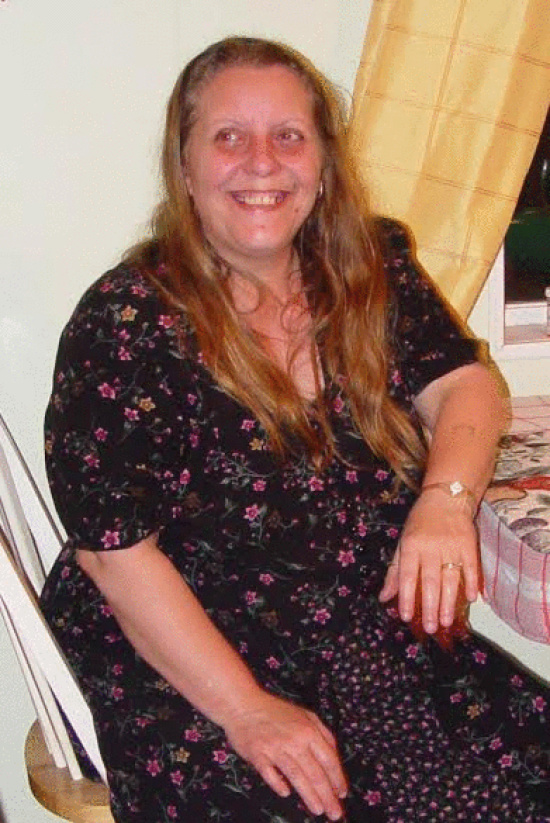Warning: This post contains graphic descriptions of violence and murder.
A memorial sign hung for Suzanne Seemann near the site of her 2012 death. Photo by Andrew Goff.
Closing arguments allow prosecutors a chance to weave the accumulated evidence in a case into a compelling yarn, creating a narrative that can be delivered with some dramatic flair. And today special prosecutor Paul Sequeira, who was brought up from the Mendocino County District Attorney’s office specifically to argue this case, took full advantage of the opportunity as he argued for the conviction of Jason Anthony Warren on two counts of murder and two counts of attempted murder.
With the courtroom filled nearly to capacity this afternoon, Sequeira stood at a lectern facing the jury and began his presentation with some grand statements about the U.S. Constitution, freedom (it isn’t free) and the American jury system, which he called “one of the greatest expressions of our freedoms.”
Then he moved into the legal definitions of — and burdens of proof required for — the charges in this case, including special allegations of torture and lying in wait in connection with the Sept. 27, 2012, murder of Hoopa resident Dorothy Ulrich. This was ground covered at length earlier in the afternoon by Judge Timothy Cissna, but Sequeira went over the ground again, as if to say he welcomed the burden of proof and was more than happy to provide it.
He also added some context to the dry legal definitions. Murder in the first degree requires malice aforethought, whether implied or express, Sequeira said. Like if you were to “smash someone’s head with a sword,” he added, referencing the alleged murder weapon in Ulrich’s death.
Lying in wait involves concealing your purpose and waiting for an opportunity to act before unleashing a surprise attack. That doesn’t necessarily mean a bad guy jumping out from behind a bush, Sequeira said. It could be someone who was hanging out with the victim all day, as Warren did with Ulrich.
Sequeira said he had tried to present evidence in the case the way law enforcement encountered it, and then worked backwards to piece together the crimes.
“Now I’m going to go real time,” he said. And here’s where his story began in earnest.
Ulrich, he said, “made a fatal mistake” by bringing Warren back to her house that fateful September day when she bumped into him at the Hoopa Minimart. We don’t know what arrangement she made with him, and it’s not important, Sequeira said. “But we do know one thing.” Warren remained at or near Ulrich’s trailer for the next 18 hours, until about 4:20 a.m., “when we get to the attack,” Sequeira said.
Here the prosecutor paused and told the jury that he’d been struggling with the decision of whether or not to play People’s exhibit No. 152 one more time. That’s the audio track captured by a security camera during the attack, a recording on which the jury heard Ulrich screaming in pain and confusion as blows rained down on her.
It’s the prosecution’s best piece of evidence. “We played it three times, but we won’t again,” Sequeira said, because it’s “so disturbing.” Instead he described the attack, arguing that Warren had countless opportunities to stop but instead made the “willful, deliberate and premeditated” decision to keep going.
The jury was shown graphic autopsy photos of Ulrich’s body as Sequeira argued that the wounds proved the allegation of torture. (Ulrich’s mother got up and left the courtroom when the pictures came on the big digital monitor.) While there were four deep and penetrating wounds in Ulrich’s back, she also suffered shallow stab wounds to the front of her torso.
“Who does that if they don’t intend pain?” Sequeira demanded in a loud voice. “Who just pokes and jabs?”
With a medium-sized samurai sword in his hand, Sequeira gestured and asked again, “Who does that? … And for how long? Almost three minutes.” The weapon he was holding, he reminded the jury, was the “baby brother” of the actual murder weapon. And he reminded the jury that the audio recording begins with a long period of silence.
“And you hear the — ” WHAM! Sequeira whacked the legal pad sitting atop the lectern with the sheath of the samurai sword, and the loud report gave the courtroom a jolt.
The recording, People’s No. 152, was disturbing to listen to in the courtroom, he said. “Can you imagine living that? And being there?”
Ulrich had defensive wounds on her arms and shoulders, a contusion on her leg as if she’d been struck with the side of the sword, and a “killing blow” among the wounds to the back of her head. On the recording she could be heard screaming “Please stop! Please stop! I can’t take no more.”
“Can you imagine the mental anguish she went through?” Sequeira asked the jury. Warren, he added, “definitely had the option to stop. And what did he say? ‘Shut up and be quiet.’”
Warren showed express malice, Sequeira argued. “He tortured her to death.”
The prosecutor then reminded the jury of all the evidence identifying Warren, including law enforcement officers who recognized him on the security video. But the best identification, he said, came from Dorothy Ulrich herself. Even though she couldn’t be in the courtroom, she called out his name multiple times on the audio recording. “She told you all who killed her,” Sequeira said.
Science identifies Warren as the killer, too, he added, reminding the jury that Ulrich’s blood was found on Warren’s shoe and shorts, with more blood found on his shirt and jacket.
After killing Ulrich, Warren stole a car and fled, Sequeira said, similar to what he admitted doing back in 2001 after stabbing a cab driver in the chest, back and arms for no apparent reason. Warren fled from Hoopa and came to Myrtle Avenue, just north of Eureka, where he encountered three runners — not joggers — Suzanne Seemann, Terri Vroman Little and Jessica Hunt, Sequeira said.
Here again, as with the Ulrich murder, Sequeira recounted the physical evidence and said it offered proof of murderous intent. In a case without many indisputable facts there was at least this one, he said: The victims were hit from behind. That’s a lot like how an Arcata cyclist was struck from behind by a car driven by Warren back in 2001, Sequeira said, referring to his conviction at age 16.
In order to strike the runners from behind, a northbound car would have had to move across the opposite lane and well into the shoulder. And could it possibly be a tragic coincidence, Sequeira asked, that the car managed to hit all three women and their dog, striking Vroman Little dead-center hard enough to shatter the windshield.
Sequeira pointed out other “eerie” similarities between the 2012 incidents and Warren’s 2001 crimes, including the fact that both stolen cars were later abandoned and, in both cases, the side-view mirror popped out and was later found along the side of the road.
Ulrich’s wallet was found tossed onto an upstairs patio near where the car was abandoned, and Warren was later arrested after holing up at his best friend’s house nearby, Sequeira said.
“If that’s all [the evidence] I had” it would be enough to prove Warren guilty beyond a reasonable doubt, Sequeira argued. But again, there’s science to back him up, he said, reminding the jury of the shattered windshield glass found in Warren’s clothes and the fibers found on the car’s driver’s seat that were consistent with Warren’s jacket.
“It’s all consistent,” Sequeira said, “but there’s the defense case.”
Right there, Judge Cissna cut him off. It was 4:30 p.m., and Cissna said he had other court business to attend to before the day was out.
Sequeira seemed to be approaching the conclusion of his presentation, and the interruption stopped him cold. But the finale will have to wait until tomorrow morning, as will the closing argument from defense attorney Glenn Brown.
PREVIOUSLY:
- Jury Hears Audio of Dorothy Ulrich’s Violent Death on First Day of Warren Trial
- Attorneys Spar Over Evidence Before Warren’s Health Forces Early Recess in Double-Murder Case
- Jury Sees Photos of Battered, Blood-Smeared Kia on Day Three of Warren Trial
- Warren Trial, Day Four: Security Footage, Samurai Swords and a Vanishing Witness
- Warren Trial, Day Five: ‘The Type of Scream You Hear in a Horror Movie’
- Warren Trial, Day Six: The Evidence Mounts
- Warren Trial, Day Seven: The Autopsies
- Warren Trial, Day Eight: The DNA Matches, But Warren’s Wife Stops Short of Positive ID
- Warren Trial, Day Nine: Murders Foreshadowed by Similar Crimes a Decade Earlier
- Warren Trial, Day 10: Doctor Details Brain Injuries of Hit-and-Run Victims
- Warren Trial, Day 11: Both the Prosecution and Defense Rest


CLICK TO MANAGE